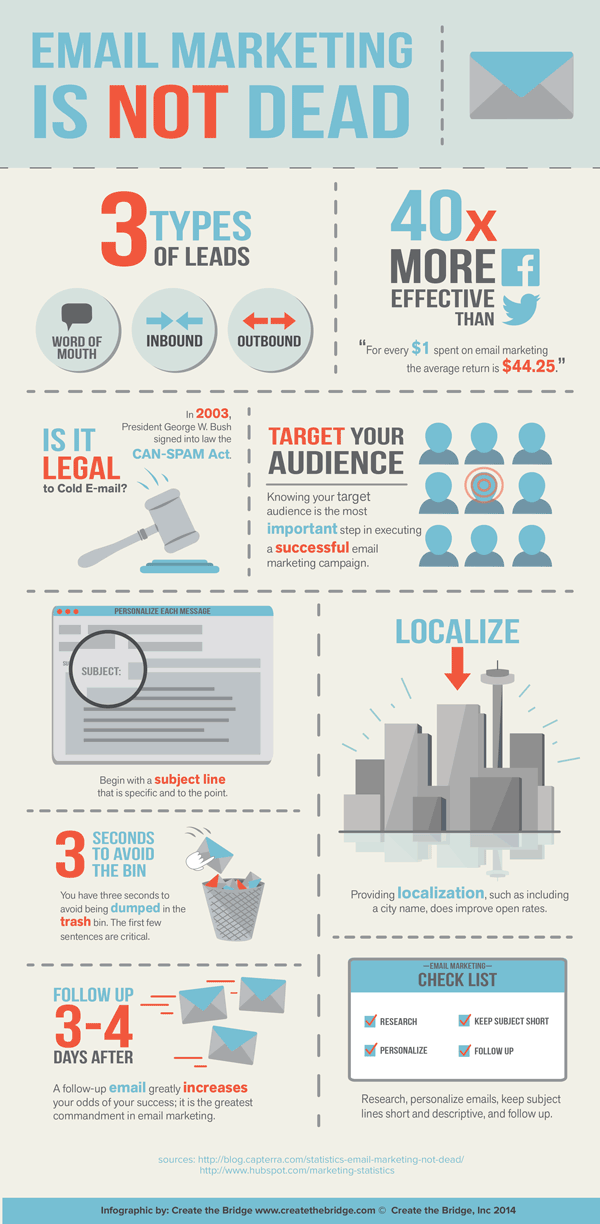
A big problem most startups face these days is acquiring new leads. As much as we encourage the use of inbound marketing techniques, there needs to be effective programs running across all three types of leads: word of mouth, inbound and outbound leads.
![]()
Cold e-mailing is a very effective and untapped form of marketing, not to mention the cheapest one also. If you’re wondering why marketers seem intent on e-mailing you more and more, there’s a simple explanation: it works. But, will it always work? No. Most people do not feel comfortable communicating with strangers, and that can't be held against them. However, if done correctly, email marketing can greatly increase your marketing campaigns.
But, isn’t email marketing dead and thus ineffective? Actually… no. The best marketing organizations view every e-mail as an opportunity to learn more about their consumer and 89% of marketers said email was their primary channel for lead generation. (http://www.hubspot.com/marketing-statistics)
Also, according to a study done this year, (http://blog.capterra.com/statistics-email-marketing-not-dead/ ), for every $1 spent on email marketing, the average return is $44.25. The study also shows that E-mail is still a significantly more effective way to acquire customers than social media by acquiring nearly 40 times that of Facebook and Twitter combined! Email marketing is certainly not dead. It is surely alive!
![]()
Now, the next question that arises, is it legal to cold email potential customers? In 2003, President George W. Bush signed into law the CAN-SPAM Act, acronym for Controlling the Assault of Non-Solicited Pornography And Marketing. Its purpose is to prevent the sending of unsolicited email. In summary, you can avoid any legal issues if you adhere to CAN-SPAM guidelines:
![]()
Don't use false or misleading Header Information
Don't have a deceptive subject line-Use a subject line that accurately reflects the content of your e-mail.
Include Sender’s Postal Address
Identify the message as an ad
Tell recipients how to opt out of receiving future email from you- include a working "unsubscribe" link in every mail you send
There is a difference when an email is directed to someone with a sales pitch than blasting that same message to an entire list of people which quickly becomes spam. Compliance with email marketing laws ensures that you stay out of legal trouble and that your emails are welcome.
So how do you improve your email open rates, response and click through rates?
When deciding to read an email or not, there is a common evaluation process that occurs:
- Who is emailing me (and is this spam)?
- What do they want?
- How long will it take? If you want to get yourself heard, make sure to know the following.
![]()
Knowing your target audience is, without a doubt, the most important step in executing a successful email marketing campaign. It’s really sad to watch, but it happens thousands and thousands of times each day. The quickest way to ruin your chances of a sale is to choose the wrong prospect.
As with any marketing, you should spend time creating customer personas. If you don't do your homework and do not understand who it is you're speaking to, you will be crippling your chances for success. You can check their websites, follow them on social media, and find out their followers.
For cold-emailing to work, you have to write things that your prospects care about. The more information you get, the higher the probability in them replying.
Now that you did your homework, you can start crafting the perfect message.
Begin with a subject line that is specific and to the point. Like mentioned above, make sure the subject line is neither false nor misleading. It should summarize the message in the email and set expectations properly.
Get right to the point in about six to eight words. Personalization, such as including a recipient's first name or last name, didn't significantly improve open rates.
![]()
- Providing localization however, such as including a city name, does improve open rates. Remember, the subject is the most crucial string in the email since the opening rate of the message depends so much on it.
![]()
When you get to the message itself, you have three seconds to avoid being dumped in the trash bin. In one sentence, you should be able to answer the question,
"What do you want?"
Therefore, the first few sentences are critical so do not write your whole life story. Remember, it’s all about the other person. Typically the first sentence should include your name, where you’re from and what you’re inspiring to do.
![]()
Personalize each message. Take the time to find the name of the prospect. The success of the message depends on how well you connect with the recipient. You should have a special reason to contact the person and if you create a connection, your success rate shoots through the roof.
![]()
Also, keep the message short. Remember that people are busy and are annoyed by long messages. You should state the purpose of the email right away and not try to cover anything up. If you don’t receive a reply, you should send a follow up email about 3-4 days after the first one asking if they received the first email and to make sure it was not sent to spam folder.
A follow up email greatly increases your odds of your success; it is the greatest commandment in email marketing. If you do not get a reply from the first email, don’t take it personally. Follow-up, Follow-up, Follow-up. There are people that respect persistence.
![]()
So there you have it. Do your research, personalize your emails, keep subject lines short and descriptive, and follow up. Email marketing is very much thriving. The only thing that is not effective is using blackhat, spammy techniques. But you already knew that.
Also, feel free to download this infographic for your convenience.


